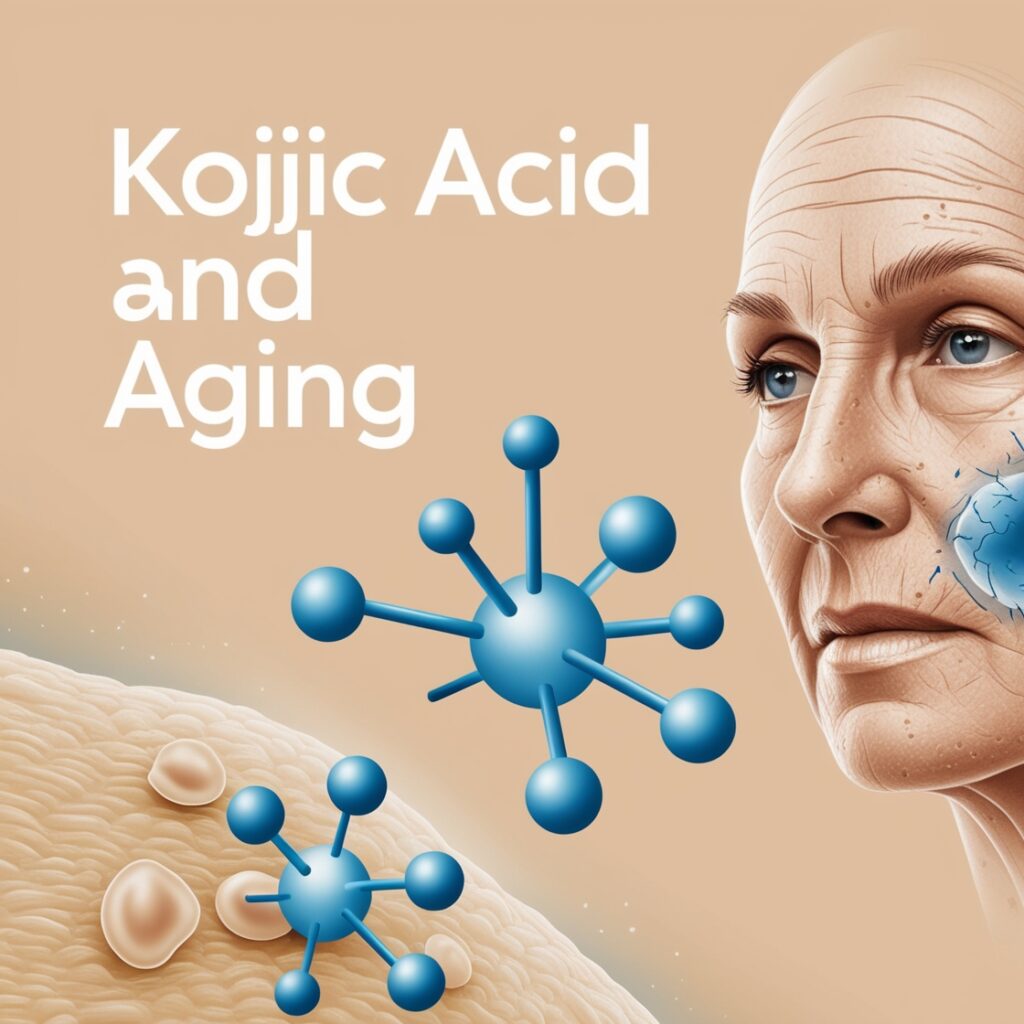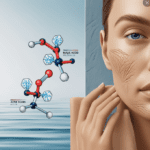Quick Summary:
- Kojic acid blocks tyrosinase, reducing melanin and preventing hyperpigmentation.
- Its antioxidant properties help neutralize free radicals, reducing fine lines and wrinkles.
- Studies show that kojic acid improves skin brightness and homogeneity.
Aging is a natural process that we all experience, but everyone wants to age gracefully. When it comes to skincare, many ingredients are praised for their anti-aging abilities, but one that stands out is kojic acid. Derived from fungi, kojic acid has gained recognition for its ability to tackle hyperpigmentation. In this article, we’ll explore the science-backed ways kojic acid helps fight aging, so you can better understand how it might fit into your skincare routine.
How Kojic Acid reduces anti ageing
Reducing Melanin for Even Skin Tone
Kojic acid blocks tyrosinase, an enzyme that contributes to melanin production. Melanin is what gives our skin its color. As we age, sun exposure, hormones, and other factors can cause overproduction of melanin, leading to dark spots, uneven skin tone, and age spots.
By inhibiting tyrosinase, kojic acid reduces melanin production. This results in a lighter skin tone and reduced hyperpigmentation. Since hyperpigmentation is one of the most noticeable signs of aging, using kojic acid can help your skin look more youthful and uniform.
Fighting Free Radicals
Another key player in aging is oxidative stress. This occurs when harmful molecules called free radicals damage our skin cells. These free radicals can be triggered by exposure to UV rays, pollution, and other environmental factors. Over time, this leads to wrinkles, fine lines, and loss of skin elasticity.
Kojic acid doesn’t just brighten your complexion; it also acts as a powerful antioxidant. It neutralizes free radicals, preventing them from damaging your skin’s cellular structure. By reducing oxidative stress, kojic acid helps to keep your skin firm and smooth for longer.
Top Benefits of Kojic Acid for Skin Health
Clinical Studies on Kojic Acid: What Science Says
In a study using hyperspectral imaging, researchers found that treatment with kojic acid led to improvements in skin brightness and evenness. About 83% of participants reported reduced hyperpigmentation after regular kojic acid use. This suggests that kojic acid is particularly effective in improving skin tone and texture, making it a valuable ingredient in anti-aging treatments.
Nanotechnology Enhances Kojic Acid’s Effectiveness
Nanotechnology is revolutionizing skincare, and kojic acid is no exception. Studies show that incorporating kojic acid into nanotechnology-based drug delivery systems can improve its penetration and retention in the skin. This means that with new formulations, kojic acid can work even more effectively to target signs of aging.
Anti-Inflammatory and Antimicrobial Benefits
One of the reasons kojic acid is such a versatile ingredient is its range of biological activities. Beyond reducing pigmentation, kojic acid also has anti-inflammatory and antimicrobial properties. Inflammation contributes to skin aging, so reducing inflammation can help prevent the development of fine lines and wrinkles. These properties also ensure that your skin stays healthier overall, making kojic acid a comprehensive solution for aging skin.
Safe for Long-Term Use
You might wonder, is kojic acid safe to use over time? Research says yes. Kojic acid has been deemed safe for use in cosmetic products at concentrations up to 2%. This concentration has been found to be effective in lightening skin and combating signs of aging without causing harmful side effects. So, if you’re looking for a long-term solution for maintaining youthful skin, kojic acid can be a safe option.
Combination Kojic Acid with Other Ingredients
While kojic acid is effective on its own, research shows that combining it with other active ingredients can amplify its effects. For example, using kojic acid alongside amino acids may provide better results in treating pigmentation and improving skin health.
Here’s why this matters: As we age, our skin naturally loses collagen and hydration. Combining kojic acid with other agents that target these issues, such as peptides or hyaluronic acid, could lead to more comprehensive anti-aging results.
Why Kojic Acid and Amino Acids Make a Great Pair
Amino acids are the building blocks of proteins like collagen, which give our skin its structure and elasticity. By pairing kojic acid with amino acids, you’re addressing pigmentation and supporting your skin’s natural repair process. This combination helps you achieve brighter, firmer skin, a double win when fighting the signs of aging!
Is Kojic Acid Safe for All Skin Types?
hKojic acid is generally well-tolerated, but it can cause irritation in some people, especially when used in high concentrations. This is why most cosmetic products containing kojic acid limit the concentration to 2% or less, ensuring it remains gentle yet effective. If you have sensitive skin, it’s always best to start slow. Introduce kojic acid into your routine gradually, and always patch test to avoid any potential irritation.
How to Incorporate Kojic Acid into Your Skincare Routine
Now that we know how kojic acid works, let’s talk about how you can add it to your daily skincare routine to reap its anti-aging benefits.
Kojic Acid in Serums
Serums are one of the best ways to use kojic acid because they penetrate deep into the skin. After cleansing your face, apply a kojic acid serum before your moisturizer. This will allow the active ingredients to work more effectively.
Kojic Acid in Creams
If you prefer a cream, many anti-aging formulations now include kojic acid as a key ingredient. These are often combined with moisturizers, peptides, or hyaluronic acid to hydrate the skin while targeting signs of aging.
Kojic Acid Soaps
Kojic acid soaps are a gentler way to introduce the ingredient to your skin. They are particularly effective if you’re dealing with hyperpigmentation on larger areas like your back, chest, or arms.
Frequency of Use
While kojic acid is safe, it’s important to start slowly. Try using it 2-3 times a week and monitor your skin’s reaction. If your skin shows no signs of irritation, you can gradually increase to daily use. Always follow up with sunscreen when using kojic acid, as it can make your skin more sensitive to the sun.
References
Evaluation of the Reduction of Skin Hyperpigmentation Changes under Treatment with Kojic Acid
Biological activities and safety data of kojic acid and its derivatives: A review
Kojic acid: Uses, benefits, safety, and risks
Kojic acid applications in cosmetic and pharmaceutical preparations

I’m a devoted organic skincare enthusiast, passionate about the natural, wholesome goodness that organic products bring to our skin.
Organic skincare isn’t just a hobby for me—it’s a lifestyle. Every product I use, recommend, and write about has been carefully chosen for its purity and effectiveness. Everything I write about is backed by scientific studies, dermatologists’ opinions, and user experiences.
I also excel at tackling skincare challenges with innovative, organic solutions.

